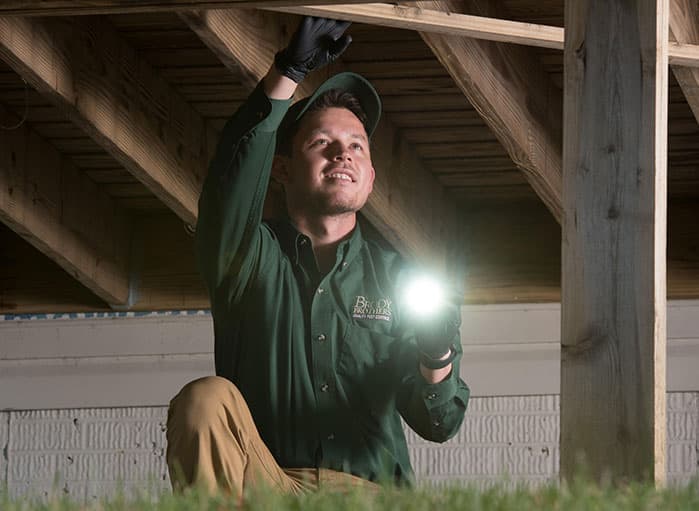Risks and Damages Caused By Ants
in Your Home or Yard
Bacterial Contamination
Ants carry bacteria on their bodies, spreading it everywhere they go – including your counters, tableware, and food. Although most ants do not transmit disease, the idea of pests spreading bacteria in your home is unpleasant at best.
Property Damage
Some ants can do serious damage to your property. Carpenter ants, for example, may chew tunnels into solid wood, such as ceiling beams, house framing, and paneling.
Difficult to Treat
Ants are the #1 species that are comfortable indoors and are notoriously tough to eliminate. Don’t let these pesky pests take comfort in your home – trust our experts to eliminate them for good.
Don’t let small problems turn into big ones.
Schedule Service Now
4 Easy Steps to Get Rid of Ants and
Restore Comfort in Your Home

1. Call
Our friendly and local customer service team is ready to help.

2. Schedule
Choose a date and time that works best for you.
3. Our Techs Get To Work
Our highly-trained technicians will swiftly and effectively address your ant infestation.

4. Relax
Sit back and enjoy your pest-free home.
Brody Stats
40
Years in Business4
Offices in Maryland320
Minimum Initial Training Hours Per Technicians2200+
Google Reviews5 Most Common Ant Species in Maryland
Curious about ant species identification?
Click on each of the ant species below to learn more about what they look like, their behaviors, and their habits.
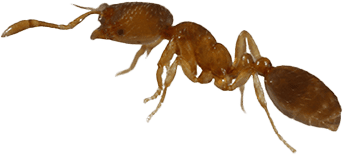
Odorous House Ants
- Size: About 1/16 inch long
- Why they enter: Most likely to enter homes in spring and after heavy rains
- Unique fact: Most common ant species found in Maryland, and if crushed, they release a foul odor similar to rotten coconut
- Colony size: Can have huge colonies, up to 5,000,000 ants
These ants are tiny, typically measuring anywhere from 2.4mm to 3.3mm in length. They can be most easily identified by their signature scent – crush one, and you’ll notice that it emits a rotten coconut smell.
Odorous house ants are often the small ants in the kitchen area – they have a sweet tooth, so don’t leave sugary food within their reach, or it’s likely that they will contaminate it. You can also find them around your pet’s food and in your bathroom.
Here are a few more tips for preventing an odorous house ant infestation in your home:
- Get rid of any standing water.
- These ants build nests in stacks of wood, so keep any firewood stored far from your home.
- Seal any cracks or openings near the bottom of your home’s foundation.
- Make sure that plants and tree branches are cut so that they don’t touch your home.
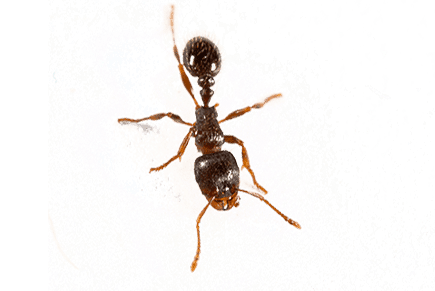
Pavement Ants
- Size: About 1/16 inch long
- Why they enter: Like warmth, so likely to live under slabs, in wall insulation, or near heat sources
- Unique fact: Nest below ground
- Colony size: 3,000-4,000 ants, with several queens
You guessed it – these ants typically build their nests in or under cracks in pavement! They can also be found inside the home in walls and under floors.
You might be surprised to learn that they aren’t common throughout the entire United States – they’re only present in the eastern half, so they’re definitely a problem here in Maryland.
To identify pavement ants, look for a light brown to black ant – it will have legs that are lighter in color than the rest of its body. They’re quite harmless and don’t bite, but they can still contaminate your food and the food preparation surfaces in your home.
Here’s how you can help prevent pavement ants from entering your home:
- Clean up quickly any time you spill your food, a beverage, or your pet’s food, and keep your kitchen as clean as possible.
- Keep all of your food stored in sealed containers.re
- Seal up your foundation and any cracks around windows/doors.
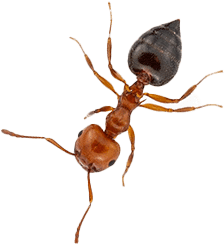
Acrobat Ants
- Size: About 1/16 inch long
- Why they enter: They look for moisture-damaged wood and spray foam insulation
- Unique fact: Like following fence lines and cable wires
- Colony size: 3,000-8,000 ants
You can easily recognize an acrobat ant – its unique, heart-shaped abdomen is a dead giveaway. These ants are small and tend to enter homes through cracks in the foundation and the small gaps around windows and doors.
When they enter your home, you might be unpleasantly surprised to find them in your food, contaminating it so that it is inedible. They also sting when threatened, so keep that in mind if you spot one.
Here are some steps you can take to prevent acrobat ants from invading your home:
- Use caulk to seal any openings around windows, doors, pipes, and utility entrances.
- Seal any cracks in the foundation and exterior walls of your home.
- Avoid leaving food and/or dirty dishes out in your kitchen, and store pet food properly.
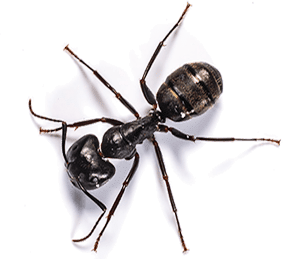
Carpenter Ants
- Size: Much larger than our other local ants 1/2 to 3/4 long
- Why they enter: Love rotted and decayed wood; often live in tree stumps, especially tulip and maple trees in
Maryland - Unique fact: Often mistaken for termite swarmers and are most active at night, usually between 10:00 PM and 2:00 AM
- Colony size: Up to 15,000 workers and can take 6-10 years to produce new queens and kings.
If you’re trying to identify carpenter ants in or around your home, ask yourself these questions:
- Do the ants have wings?
- Do the ants have a constricted waist?
- Are the ants black, red, or a combination of those colors?
- Do the ants have a one node waist?
- Did you find the ants near or inside of wood (especially water-damaged wood)?
If you answered yes to all of these questions, there is a good chance you’ve spotted carpenter ants. You may also have carpenter ants if you hear a rustling sound inside the wooden structures of your home or if you find wood shavings on your floor mixed in with dead ants.
These ants build their nests inside of wood, tunneling and removing the wood along the way. Once they enter your home, they can contaminate both human food and pet food.
Here are a few steps you can take to keep carpenter ants out of your home:
- Because carpenter ants need moisture to survive, you can keep them away by replacing water-damaged wood in or around your home. Also, check your gutters to make sure that they are properly draining water away from your home.
- If you have firewood, be sure to store it as far from your home as possible.
- Trim any trees and/or bushes so that they do not come into contact with the walls of your home.
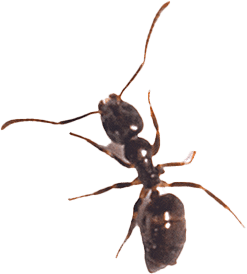
Joseph Berger, Bugwood.org
Thief Ants
- Size: About 1/16 inch long, but queens can be three times that size
- Why they enter: Love warmth so likely to be found inside walls, cabinets, and behind baseboards
- Unique fact: Like stealing resources from other ant species
- Colony size: 500-2000 ants, with several queens
You can identify these ants by their size and color. They’re one of the tiniest household ants in the world, usually measuring from 1.5mm to 2.2mm in length, and they range in color from yellowish to brown.
And yes – they really are thieves! In fact, they’re called thief ants because they steal larvae and pupae from neighboring ant colonies. They have another nasty habit too – they sometimes feed on dead rodents, meaning they’ll contaminate your food if they come into contact with it.
Here’s how to stop thief ants from invading your home:
- First, make sure you’ve correctly identified the ants. Thief ants look similar to Pharaoh ants, and if you can’t tell them apart, you should contact your favorite residential pest control provider for help.
- Keep your kitchen and home clean. Make sure you don’t let food scraps and dirty dishes sit out for long periods of time.
- Make sure that any vegetation is kept away from your home’s foundation.
To learn more, check out 5 Common Types of Ants in Maryland.
Discover Why We’re The Trusted Ant Extermination
Experts in Baltimore
Selective Hiring
We take our hiring process seriously. We know inviting someone into your home is a big decision. That’s why we carefully select and vet our technicians. Your comfort and trust are our utmost priority.
Extensive Training
Our technicians undergo 320 hours of comprehensive training on pests and ant treatment options before they can service homes. We go above and beyond industry standards to ensure our techs are true experts in safe and effective pest control.

Family-Focused, Eco-Friendly Pest Control Solutions
Rest easy knowing our pest control treatments are highly effective in eliminating pests and have also been rigorously tested and proven eco-friendly. Your family’s safety is our top priority.

A Team that Goes the Extra Mile
Expect exceptional customer service from our entire team. Our skilled technicians use only the highest-quality products and go beyond simply treating existing pest problems. They also proactively address common areas to prevent future pests.

Impeccable Reputation
For nearly 40 years, we’ve built a stellar reputation. With 2200+ Google reviews and a 4.9-star rating, our commitment to customer satisfaction is unmatched!
Our team is ready to help with professional ant removal.
Call now for a FREE quote and schedule your ant removal service today.
What to Expect with Brody’s Ant Extermination Services
Maintain
No need to move anything prior to our arrival. Our techs will move anything they need to and ensure they’re moved back. This approach helps to prevent pests from being disturbed from their usual hiding spots.
Identify
Each pest is unique. Our techs will inspect and identify which Maryland ant species are in your home to ensure we’re using the most effective treatment.
Investigate
We inspect known issue areas and also throughout your home to identify areas attractive to ants. We’ll also include an inspection of your yard for potential pest ant nesting sites sources.
Treat
Our technicians use targeted treatment placements to treat all identified problem areas inside your home, the perimeter of your home’s foundation, and secondary locations on your property, eliminating ant trails, pathways, and colonies.
Prevent
We take proactive measures through regular seasonal treatments to effectively deter ants, preventing large colony development on your property and safeguarding your home from ants invading your living space
Follow Up
Our technicians will follow up with you 2 weeks after your initial service to confirm if the ant colonies have been eliminated. They will return for follow-up visits until your pest issue is managed.
Frequently Asked Questions about Ants
Looking for effective ant extermination? While various ant exterminator companies employ different approaches, ant traps and bait are the most commonly used methods to eliminate ant problems efficiently.
At Brody Brothers Pest Control, our approach involves a comprehensive treatment plan for ants. We use a variety of professional-grade products and sprays specifically designed to target ant colonies. This includes targeted interior applications to address active ant infestations, perimeter treatments for the exterior of your property, and additional focus on secondary areas located away from the house.
When it comes to getting rid of ants, ant traps and bait are widely utilized by professional ant exterminators.
At Brody Brothers, we use a variety of professional-grade products and sprays specifically designed to target ant colonies. These effective methods, available in different forms such as gels, granules, or stations, are specifically designed to target ants’ dietary preferences.
Click here to learn more about Brody Brother’s ant control services.
Our Technicians:
- Complete more than 320 hours of training to thoroughly understand pests and their habits, pest treatment options and tools, and the environmental impact of treatments.
- Treat your home with the same respect as they would their own, including always wearing shoe coverings inside and putting everything back the way they found it.
- Know to use the right product for the right ant species.
- Don’t just treat your home for the known pest problem. They’ll also treat common areas to deter future pests.
- Love animals and eliminate pests from your home as humanely as possible.
Our Process:
- Environmentally friendly, including being aware of water sources, bees, etc.
- Treat any pipes, utilities, or connection lines so pests can’t get around/circumvent the barrier.
- Use non-repellent ant bait to ensure they won’t bypass it and that they will transfer it, making it more effective at targeting the greater colony.
- Treatment of your home’s perimeter for a longer control, then treat secondary places on your property.
- Brush away cobwebs so spiders are less likely to make webs and wasps are less likely to build nests.
- Treat the colony around your entire property.
- Timed seasonal ant treatments for effective success
Our Products:
- Environmentally friendly – we carefully evaluate each product for human & environmental impact.
- Only the highest quality products – we test them all!
Ants may enter your house for several reasons:
- Food: They are attracted to even small amounts of food, such as crumbs, sweets, or pet food.
- Moisture: Ants seek out sources of water or damp areas in your home.
- Nesting: Your house may provide a suitable environment for ants to establish their nests.
- Weather conditions: Adverse weather like heavy rain, cold, or hot weather can drive ants indoors in search of shelter.
Here’s how to keep ants out of your house and maintain a pest-free environment:
- Keep your kitchen, dining room, and pantry clean. Regularly sweep the floors, wipe off countertops daily, and ensure all food items are properly sealed.
- Act quickly to clean up food spills. If you accidentally spill food or drink, make sure to promptly clean it up to avoid attracting ants.
- Eliminate food crumbs after every meal. Thoroughly wipe down counters and tables with warm soapy water to remove any food residue. Pay attention to crevices and corners where crumbs can hide. This is especially important if you have young children who tend to leave crumbs around the living room or kitchen.
- Keep surfaces dry. Ensure that counters, sinks, and floors are thoroughly dried after cleaning or any spills. Standing water or moisture can attract ants.
- Take out the trash promptly and keep garbage cans tightly sealed. Dispose of trash, particularly items with strong odors, immediately after use. Remember, ants are drawn to sugary treats!
- Store food in sealed baggies or airtight containers. Avoid leaving any food uncovered as it can easily attract ants.
- Maintain cleanliness around your pet’s food area. Keep your pet’s food bowl clean and tightly seal pet food containers. Pets may leave behind crumbs after eating, so be sure to sweep or vacuum the area regularly. Consider storing pet food in a large, airtight plastic container instead of its original packaging.
- Monitor indoor humidity levels. Certain ant species, like odorous house ants, acrobat ants, and carpenter ants, are attracted to damp wood for its moisture content. Be mindful of indoor humidity and address any potential moisture issues promptly.
For more information about how to get rid of ants in your home, check out How Do I Get Rid of an Ant Infestation.
Here’s how to keep ants out of your yard and maintain a pest-free outdoor space:
- Trim outdoor branches and shrubbery. Cutting back all of the branches and shrubbery close to your home can inhibit ants from nesting. Ants use these elements to bypass the treated perimeter of your home.
- Don’t over-mulch. It’s recommended to keep mulch depth under three inches.
- Don’t leave tree stumps or rotting wood lying around. Rotting wood attracts ants. Avoid any situations where wood is in direct contact with the ground or right next to your home. Monitor wood decay and replace damaged wood as necessary.
- Eliminate yard debris, especially close to your home. Remove piles of debris, like leaves, firewood, or bricks, and ensure your gutters aren’t clogged.
- Notice the plants in your yard. Control aphids, a.k.a. plant lice, on your favorite flowers and shrubs, such as crepe myrtles, rose bushes, American holly, peonies, any type of maple, and English ivy.
- Be mindful of your neighbors’ yards. Ant colonies like odorous house ants are very large, have multiple queens, and spread across multiple properties. This is especially true if your home is in close proximity to neighbors, such as most single-family and townhome communities. Therefore, while we can exterminate ants from your home and property, there’s a good chance the remaining ants on your neighbor’s property will make their way back to yours at a future point. For these reasons, a regular inspection plan is needed to ensure long-term ant management.
For more information about how to get rid of ants in your yard, check out How Do I Get Rid of an Ant Infestation.
Ants have a varied diet, but they are particularly fond of sweets. They are attracted to a sugary substance called “honeydew,” which is secreted by aphids. You can find ants indulging in honeydew on plants like crepe myrtles, rose bushes, American holly, peonies, various types of maple trees, and English ivy. In the absence of aphid food sources during winter, ants may venture into homes in search of human food, especially sweet treats. So, while ants primarily feed on natural sources like aphids and plant sap in nature, their diet expands to include human food when they enter our homes.
Ants can be found in various areas of a home, seeking out any available crevice. Here are some of the most common places where you may find ants in your house:
- Kitchen counter and around the sink
- Bathrooms
- Leaking sinks
- Cupboards
- Bathrooms where pipes connect
- Dishwashers
- Utility areas
- Moisture-damaged wood in the basement, attic, or garage
- Cracks and crevices around door frames and windows
- These locations provide ants with access to food, water, and shelter, making them attractive spots for ant activity in your home.
Some of the most popular places you’ll find ants in your yard are:
- Piles of debris
- Compost bin
- Shed
- Under tarps
- Mailbox
- Potted plants
- Stumps
- Log piles
- Leaves
- Under Mulch
Ants are attracted to various elements such as moisture, warmth, and sugary substances. They can be found in high moisture areas, like clogged gutters or small wet spots in the kitchen or bathroom. Ants also seek out sweet crumbs and are drawn to sources of food. During the summer, they often seek shade provided by your home, while in the winter, they may be found on the sunny side of your house or seeking warmth indoors. Additionally, ants look for shelter from rain and may seek refuge in protected areas.
Ants in Maryland tend to be more active during late fall and early spring when their food options are limited. While they can pose a problem throughout the year, these seasons are when they are more likely to be noticeable.
The cost of ant extermination can vary depending on the pest control treatment plan needed for your home and yard. Contact Brody Brothers Pest Control to speak with our experts about your specific needs so we can tailor a plan just for you.
While store-bought ant repellent sprays such as store-bought ant killer sprays can kill a small number of visible ants upon contact, they may not effectively address the entire ant problem. These sprays only target a small fraction of the ant colony In some cases, using repellent sprays can inadvertently trap ants inside your home, cutting them off from the main colony. This means you may still have to deal with the unseen ant colony and potential reinfestation. To effectively tackle ant issues, it is important to locate and treat the entire ant colony throughout your home and yard, which store-bought ant repellents may not be capable of accomplishing. Consider employing comprehensive ant control strategies that involve locating and addressing the source of the infestation.
Your Comfort Is a Call Away
Our customer care team is local and ready to help with professional ant removal! Call for a FREE quote and schedule your ant control service today.
100% Satisfaction Guaranteed
As a Home Protection Plan customer, if you’re not satisfied with our pest control service, we will service your home at no additional cost until your issue is solved or receive your money back from your last scheduled service.



